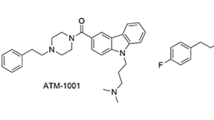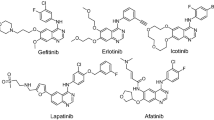Abstract
Actin-binding natural products have been identified as a potential basis for the design of cancer therapeutic agents. We report flexible docking and QSAR studies on aplyronine A analogues. Our findings show the macrolide ‘tail’ to be fundamental for the depolymerisation effect of actin-binding macrolides and that it is the tail which forms the initial interaction with the actin rather than the macrocycle, as previously believed. Docking energy scores for the compounds were highly correlated with actin depolymerisation activity. The 3D-QSAR models were predictive, with the best model giving a q 2 value of 0.85 and a r 2 of 0.94. Results from the docking simulations and the interpretation from QSAR “coeff*stdev” contour maps provide insight into the binding mechanism of each analogue and highlight key features that influence depolymerisation activity. The results herein may aid the design of a putative set of analogues that can help produce efficacious and tolerable anti-tumour agents. Finally, using the best QSAR model, we have also made genuine predictions for an independent set of recently reported aplyronine analogues.












Similar content being viewed by others
References
Sheterline P, Clayton J, Sparrow JC (1998) Actin, 4th edn. Oxford University Press, New York
Carlier MF (1998) Control of actin dynamics. Curr Opin Cell Biol 10:45–51
Carlier MF, Pantaloni D (1997) Control of actin dynamics in cell motility. J Mol Biol 269:459–467
Pollard TD, Borisy GG (2003) Cellular motility driven by assembly and disassembly of actin filaments. Cell 112:453–465
Westphal M, Jungbluth A, Heidecker M, Mühlbauer B, Heizer C, Schwartz JM, Marriott G, Gerisch G (1997) Microfilament dynamics during cell movement and chemotaxis monitored using a GFP-actin fusion protein. Curr Biol 7:176–183
Pollard TD, Cooper JA (1986) Actin and actin-binding proteins: a critical evaluation of mechanisms and functions. Ann Rev Biochem 55:987–1035
dos Remedios CG, Chhabra D, Kekic M, Dedova IV, Tsubakihara M, Berry DA, Nosworthy NJ (2003) Actin binding proteins: regulation of cytoskeletal microfilaments. Physiol Rev 83:433–473
Stossel TP (1989) From signal to pseudopod. How cells control cytoplasmic actin assembly. J Biol Chem 264:18261–18264
Lambrechts A, Van Troys M, Ampe C (2004) The actin cytoskeleton in normal and pathological cell motility. Int J Biochem Cell Biol 36:1890–1909
Allingham JS, Klenchin VA, Rayment I (2006) Actin-targeting natural products: structures, properties and mechanisms of action. Cell Mol Life Sci 63:2119–2134
Button E, Shapland C, Lawson D (1995) Actin, its associated proteins and metastasis. Cell Motil Cytoskelet 30:247–251
Giganti A, Friederich E (2003) The actin cytoskeleton as a therapeutic target: state of the art and future directions. Prog Cell Cycle Res 5:511–525
Jordan MA, Wilson L (1998) Microtubules and actin filaments: dynamic targets for cancer chemotherapy. Curr Opin Cell Biol 10:123–130
Yeung KS, Paterson I (2002) Actin-binding marine macrolides: total synthesis and biological importance. Angew Chem Int Ed Engl 41:4632–4653
Klenchin VA, Allingham JS, King R, Tanaka J, Marriott G, Rayment I (2003) Trisoxazole macrolide toxins mimic the binding of actin-capping proteins to actin. Nat Struct Biol 10:1058–1063
Spector I, Braet F, Shochet NR, Bubb MR (1999) New anti-actin drugs in the study of the organization and function of the actin cytoskeleton. Microsc Res Tech 47:18–37
Tanaka J, Yan Y, Choi J, Bai J, Klenchin VA, Rayment I, Marriott G (2003) Biomolecular mimicry in the actin cytoskeleton: mechanisms underlying the cytotoxicity of kabiramide C and related macrolides. Proc Natl Acad Sci USA 100:13851–13856
Tanaka J, Blain JC, Allingham JS (2008) Actin-binding toxin “tail” wags the dog. Chem Biol 15:205–207
Hirata K, Muraoka S, Suenaga K, Kuroda T, Kato K, Tanaka H, Yamamoto M, Takata M, Yamada K, Kigoshi H (2006) Structure basis for antitumor effect of aplyronine A. J Mol Biol 356:945–954
Kigoshi H, Suenaga K, Takagi M, Akao A, Kanematsu K, Kamei N, Okugawa Y, Yamada K (2002) Cytotoxicity and actin-depolymerizing activity of aplyronine A, a potent antitumor macrolide of marine origin, and its analogs. Tetrahedron 58:1075–1102
D’Auria MV, Paloma LG, Minale L, Zampella A, Verbist JF, Roussakis C, Debitus C, Patissou J (1994) Reidispongiolide A and B, two new potent cytotoxic macrolides from the New Caledonian sponge Reidispongia coerulea. Tetrahedron 50:4829–4834
Allingham JS, Tanaka J, Marriott G, Rayment I (2004) Absolute stereochemistry of ulapualide A. Org Lett 6:597–599
Roesener JA, Scheuer PJ (1986) Ulapualide A and B, extraordinary antitumor macrolides from nudibranch eggmasses. J Am Chem Soc 108:846–847
Yamada K, Ojika M, Ishigaki T, Yoshida Y, Ekimoto H, Arakawa M (1993) Aplyronine A, a potent antitumor substance, and the congeners aplyronine B and C isolated from the sea hare Aplysia kurodai. J Am Chem Soc 115:11020–11021
Suenaga K, Kamei N, Okugawa Y, Takagi M, Akao A, Kigoshi H (1997) Cytotoxicity and actin depolymerizing activity of aplyronine A, a potent antitumor macrolide of marine origin, and the natural and artificial analogs. Bioorg Med Chem Lett 7:269–274
Saito S, Watabe S, Ozaki H, Kigoshi H, Yamada K, Fusetani N, Karaki H (1996) Novel actin depolymerizing macrolide aplyronine A. J Biochem 120:552–555
Klebe G, Abraham U, Mietzner T (1994) Molecular similarity indices in a comparative analysis (CoMSIA) of drug molecules to correlate and predict their biological activity. J Med Chem 37:4130–4146
Burtnick LD, Koepf EK, Grimes J, Jones EY, Stuart DI, McLaughlin PJ, Robinson RC (1997) The crystal structure of plasma gelsolin: implications for actin severing, capping, and nucleation. Cell 90:661–670
Sun HQ, Yamamoto M, Mejillano M, Yin HL (1999) Gelsolin, a multifunctional actin regulatory protein. J Biol Chem 274:33,179–33182
Spartan (2008) Wavefunction Inc., Irvine
Halgren T (1996) Merck molecular force field: I–V. J Comp Chem 17:490–641
Gasteiger J, Marsili M (1980) Iterative partial equalization of orbital electronegativity—a rapid access to atomic charges. Tetrahedron 36:3219–3228
Sanner MF (1999) Python: a programming language for software integration and development. J Mol Graph Model 17:57–61
Huey R, Morris GM, Olson AJ, Goodsell DS (2007) A semiemirical free energy force field with charge-based desolvation. J Comput Chem 28:1145–1152
Morris GM, Goodsell DS, Halliday RS, Huey R, Hart WE, Belew RK, Olson AJ (1998) Automated docking using a lamarckian genetic algorithm and an empirical binding free energy function. J Comput Chem 19:1639–1662
Melville JL, Moal IH, Baker-Glenn C, Shaw PE, Pattenden G, Hirst JD (2007) The structural determinants of macrolide-actin binding: in silico insights. Biophys J 92:3862–3867
Bottoms CA, White TA, Tanner JJ (2006) Exploring structurally conserved solvent sites in protein families. Proteins 64:404–421
Ogata K, Wodak SJ (2002) Conserved water molecules in MHC class-I molecules and their putative structural and functional roles. Protein Eng 15:697–705
Roberts BC, Mancera RL (2008) Ligand-protein docking with water molecules. J Chem Inf Model 48:397–408
Shaltiel S, Cox S, Taylor SS (1998) Conserved water molecules contribute to the extensive network of interactions at the active site of protein kinase A. Proc Natl Acad Sci USA 95:484–491
Szybki Version 1.1.2 (2008) OpenEye Scientific Software Inc., Santa Fe
Wildman SA, Crippen GM (1999) Prediction of physicochemical parameters by atomic contributions. J Chem Inf Comput Sci 39:868–873
Hou TJ, Xia K, Zhang W, Xu XJ (2004) ADME evaluation in drug discovery. 4. Prediction of aqueous solubility based on atom contribution approach. J Chem Inf Comput Sci 44:266–275
Humphrey W, Dalke A, Schulten K (1996) VMD: visual molecular dynamics. J Mol Graph 14:33–38
Cole JC, Murray CW, Nissink JW, Taylor RD, Taylor R (2005) Comparing protein-ligand docking programs is difficult. Proteins 60:325–332
Wada S, Matsunaga S, Saito S, Fusetani N, Watabe S (1998) Actin-binding specificity of marine macrolide toxins, mycalolide B and kabiramide D. J Biochem 123:946–952
Perkins R, Fang H, Tong W, Welsh WJ (2003) Quantitative structure-activity relationship methods: perspectives on drug discovery and toxicology. Environ Toxicol Chem 22:1666–1679
Rücker C, Rücker G, Meringer M (2007) y-randomization and its variants in QSPR/QSAR. J Chem Inf Model 47:2345–2357
Wold S, Eriksson L (1995) In: van de Waterbeemd H (ed) Chemometric methods in molecular design. Wiley-VCH, Weinheim, pp 309–318
Yamada K, Ojika M, Kigoshi H, Suenaga K (2009) Aplyronine A, a potent antitumour macrolide of marine origin, and the congeners aplyronines B–H: chemistry and biology. Nat Prod Rep 26:27–43
Kitamura K, Teruya T, Kuroda T, Kigoshi H, Suenaga K (2009) Synthesis of actin-depolymerizing compounds. Bioorg Med Chem Lett 19:1896–1898
Perrins RD, Cecere G, Paterson I, Marriott G (2008) Synthetic mimetics of actin-binding macrolides: rational design of actin-targeted drugs. Chem Biol 15:287–294
Leach AR, Shoichet BK, Peishoff CE (2006) Prediction of protein-ligand interactions. Docking and scoring: successes and gaps. J Med Chem 49:5851–5855
Warren GL, Andrews CW, Capelli A-M, Clarke B, LaLonde J, Lambert MH, Lindvall M, Nevins N, Semus SF, Senger S, Tedesco G, Wall ID, Woolven JM, Peishoff CE, Head MS (2006) A critical assessment of docking programs and scoring functions. J Med Chem 49:5912–5931
Acknowledgments
We thank Craig Bruce for advice and useful discussions.
Author information
Authors and Affiliations
Corresponding author
Electronic supplementary material
Below is the link to the electronic supplementary material.
Rights and permissions
About this article
Cite this article
Hussain, A., Melville, J.L. & Hirst, J.D. Molecular docking and QSAR of aplyronine A and analogues: potent inhibitors of actin. J Comput Aided Mol Des 24, 1–15 (2010). https://doi.org/10.1007/s10822-009-9307-y
Received:
Accepted:
Published:
Issue Date:
DOI: https://doi.org/10.1007/s10822-009-9307-y




